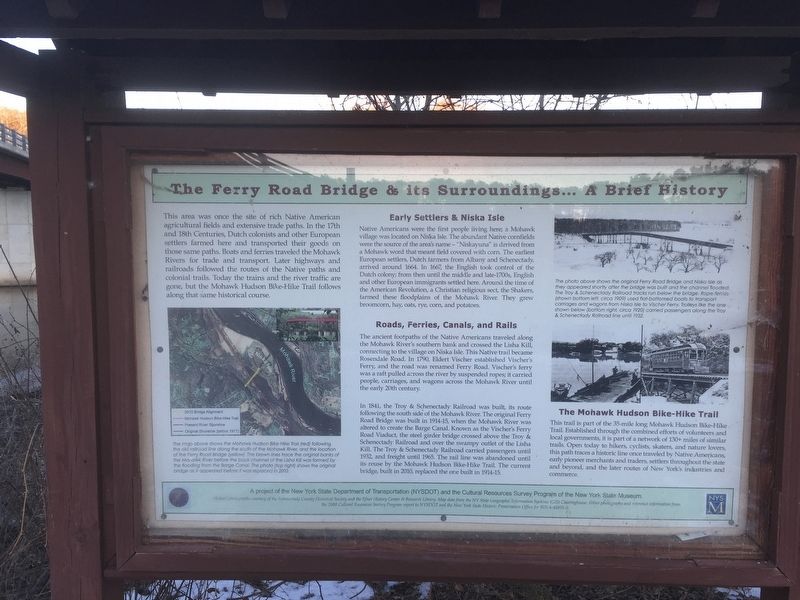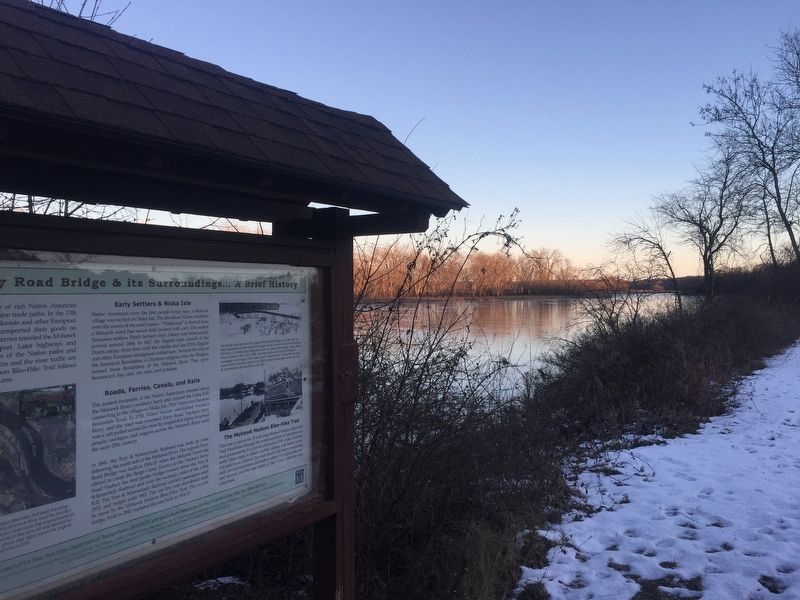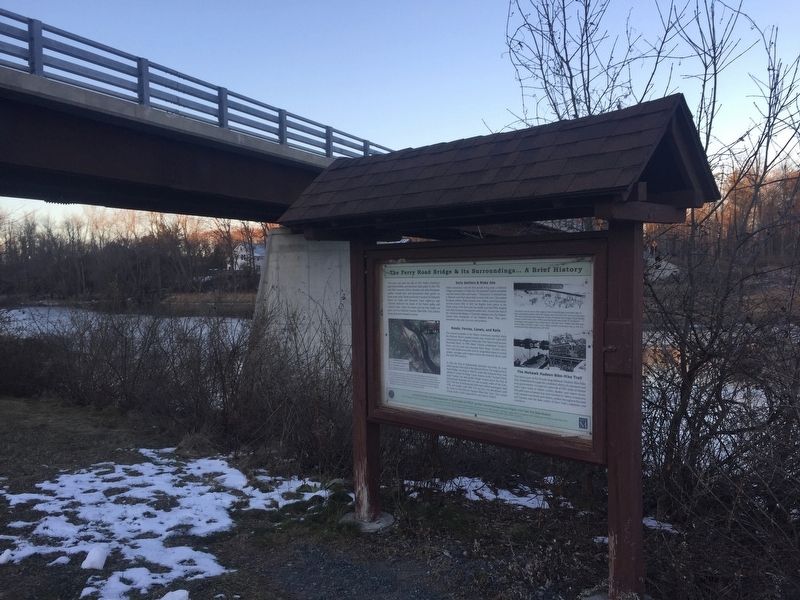Niskayuna in Schenectady County, New York — The American Northeast (Mid-Atlantic)
The Ferry Road Bridge & Its Surroundings… A Brief History
Inscription.
This area was the site of rich Native American agricultural fields and extensive trade paths. In the 17th century and 18th centuries, Dutch colonists and other European settlers farmed here and transported their goods on those same paths. Boats and ferries traveled the Mohawk Rivers for trade and transport. Later highways and railroads followed the routes of the Native paths and colonial trails. Today the trains and river traffic are gone, but the Mohawk Hudson Bike-Hike Trail follows that same historical course.
Early Settlers & Niska Isle
Native Americans were the first people living here; a Mohawk village was located on Niska Isle. The abundant Native cornfields were a source of the area’s name- “Niskayuna” is derived from a Mohawk word meant field covered with corn. The earliest European settlers, Dutch farmers from Albany and Schenectady, arrived around 1664. In 1667, the English took control of the Dutch colony; from then until the middle and late 1700’s, English and other European immigrants settled here. Around the time of the American Revolution, a Christian religious sect, the Shakers, farmed these floodplains of the Mohawk River. They grew broomcorn, hay, oats, rye, corn, and potatoes.
Roads, Ferries, Canals, and Rails
The ancient footpaths of the Native Americans traveled along the Mohawk River’s southern bank and crossed the Lisha Kill, connecting to the village of Niska Isle. This Native trail became Rosendale road. In 1790, Elbert Vischer established Vischer’s Ferry, and the road was renamed Ferry Road. Vischer’s ferry was a raft pulled across the river by suspended ropes; it carried people, carriages, and wagons across the Mohawk River until the early 20th century.
In 1841, the Troy & Schenectady Railroad was built, its route following the southern bank of the Mohawk River. The original Ferry Road Bridge was built in 1914-15 when the Mohawk River was altered to create the Barge Canal. Known as the Vischer’s Ferry Road Viaduct, the steel gilder bridge crossed the Troy & Schenectady Railroad and over the swampy outlet of the Lisha Kill. The Troy & Schenectady Railroad carried passengers until 1932, and freight until 1965. The rail line was abandoned until its reuse by the Mohawk Hudson Bike-Hike Trail. The current bridge, built in 2010, replaced the one built in 1914-15.
The Mohawk Hudson Bike Trail
This trail is part of the 35-mile long Mohawk Hudson Bike-Hike Trail. Established through the combined efforts of volunteers and local governments, it is part of a network of 130+miles of similar trails. Open today to hikers, cyclists, skaters, and nature lovers, this path traces a historic line once traveled by Native Americans, early pioneer merchants and traders, settlers, throughout the state and beyond, and the later routes of New York’s industries and commerce.
Inset Lower left photo:
The map above shows the Mohawk Hudson Bike-Hike Trail (red) following the old railroad line along the south of the Mohawk River, and the location of the Ferry Road Bridge (yellow). The brown lines trace the original banks of the Mohawk before the back channel of the Lisha Kill was formed by the flooding from the Barge Canal. The photo (top right) shows the original bridge before it was replaced in 2010.
Inset Upper Right:
The photo above shows the original Ferry Road Bridge and Niska Isle as they appeared shortly after the bridge was built and the channel flooded. The Troy & Schenectady Railroad tracks ran below the bridge. Rope ferries (shown bottom left, circa 1909) used flat-bottomed boats to transport carriages and wagons from Niska Isle to Vischer Ferry. Trolleys like the one shown below (bottom right, circa 1920), carried passengers along the Troy & Schenectady Railroad line until 1932.
Erected by NYS Dept. of Transportation and Cultural Resources Survey Program of the NYS Museum.
Topics. This historical marker is listed in these topic lists: Colonial Era • Native Americans • Settlements & Settlers • Waterways & Vessels. A significant historical year for this entry is 1664.
Location. 42° 47.265′ N, 73° 50.156′ W. Marker is in Niskayuna, New York, in Schenectady County. Marker can be reached from the intersection of Ferry Road. Marker is 100 yds east the intersection along the footpath by the bridge. Touch for map. Marker is in this post office area: Schenectady NY 12309, United States of America. Touch for directions.
Other nearby markers. At least 8 other markers are within walking distance of this marker. Ferry (approx. half a mile away); Hamlet of Vischer Ferry (approx. half a mile away); The Vischer Ferry Bridge (approx. half a mile away); The Vischer Family (approx. half a mile away); Vischer Ferry Historic District (approx. 0.7 miles away); Amity Reformed Church (approx. ¾ mile away); Lock 19 (approx. 0.8 miles away); Matthew Winne Jr. (approx. one mile away).
Regarding The Ferry Road Bridge & Its Surroundings… A Brief History. Vischer Ferry is on the north side of the river. Niska Island was an island until the barge canal silted up the upstream portions of the channel.
Passengers often chose to ride the railroad to Albany (rather than stay with the boat) because the Mohawk needs to descend 86 ft to the Hudson River within the next 20 miles. It was much faster to take the railroad to Albany than to descent through the series of locks that bypassed Cohoes Falls. The original 1825 Erie Canal came north through Cohoes and proceeded north along Mohawk Street. The sixteen locks that brought the canal up around the Cohoes Falls were referred to as the “terrible sixteens” because it would take a whole day to bring your boat through them. The Albany & Schenectady Railroad and the Troy & Schenectady Railroad were among the first in the country. The Troy & Schenectady was founded in 1836. Even today, the series of locks that lift the the canal from the Hudson to the Mohawk is considered an engineering marvel.
The bike path now extends across the state - 360 miles in its entirety.
Also see . . .
1. Erie Canal State Park and NYS Barge Canal. City of Utica website entry (Submitted on November 29, 2021, by Larry Gertner of New York, New York.)
2. Cohoes Falls. Wikipedia entry (Submitted on November 22, 2018, by Steve Stoessel of Niskayuna, New York.)
3. Albany and Schenectady Railraod. Wikipedia entry (Submitted on November 22, 2018, by Steve Stoessel of Niskayuna, New York.)
4. Troy and Schenectady Railroad. Wikipedia entry (Submitted on November 22, 2018, by Steve Stoessel of Niskayuna, New York.)
Credits. This page was last revised on November 29, 2021. It was originally submitted on November 22, 2018, by Steve Stoessel of Niskayuna, New York. This page has been viewed 424 times since then and 45 times this year. Photos: 1. submitted on November 22, 2018, by Steve Stoessel of Niskayuna, New York. 2, 3. submitted on November 23, 2018, by Steve Stoessel of Niskayuna, New York. • Bill Pfingsten was the editor who published this page.


